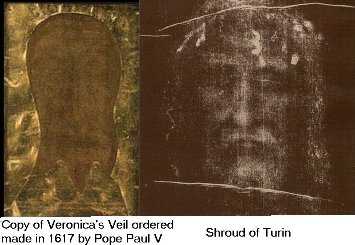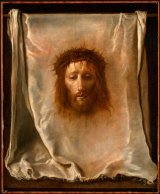Veil of Veronica - history of
[ Bible Probe ]Posted by Bible Probe on September 03, 2006 at 13:37:08:
One of the four principal relics of the Passion preserved in Saint Peter's in Rome is a cloth believed to be miraculously imprinted with the image of Christ's face.

Both images above could be showing a tired man whose face is
"puffed up" and swollen from beatings.
Since the Middle Ages, the most venerated relic of Rome and St. Peter's Basilica is the so-called “Veil of Veronica”.

It is possible that Fetti saw the actual veil when it was installed in the crossing of Saint Peter's in 1606.
According to the legend, Veronica was a pious woman from Jerusalem who encountered Christ on His way to Calvary. Deeply moved by His suffering, looking into His face pouring with sweat and blood, she wiped it with her veil - and found His portrait imprinted on the cloth when she got it back. The white, almost transparent veil measures about 6.5 by 9.5 inches and bears dark red features of a bearded man with long hair and open eyes. The face on the veil is that of a young man who has suffered greatly. He looks tired. The marks of blows that have struck him are clear: bruises and other scars on the forehead, clotted blood on his nose, one pupil slightly dilated. Yet, in spite of the evident signs of suffering and pain, the look is that of a serene man enduring his suffering with patience.
The legend continues claiming that Veronica later traveled to Rome to present her “Holy Image” to the Roman Emperor Tiberius, healing him from some severe illness. The story of Veronica and her veil does not, in fact, occur in the Bible, though the apocryphal "Acts of Pilate" gives this name to the woman with a blood flow who was cured by touching the hem of Jesus' cloak. Critics of the incidents historicity point to the very name of the saint: "Veronica" is a combination of Latin and Greek words meaning "true image." Nonetheless, the story has been a part of popular Christian culture for centuries. As early as the 300s, there were documents, which spoke of the existence of the veil, but only in the Middle Ages was it strictly connected to the Passion of Jesus Christ. Catholics have honored this tradition in their 6th Station of the Cross.
It is startling to note that the similarities between the image on Veronica's Veil and that on the Shroud of Turin only became apparent after the Shroud was first photographed in 1898.
History records the existence of this relic from the fourth century, but only from the Middle Ages was it strongly linked to the Passion of Christ. From the 12th century until 1608, it was kept in the Vatican Basilica as a popular goal of pilgrims, mentioned in Canto XXXI of Dante's "Paradise." In 1297, by the order of Pope Boniface VIII, the image was brought to St. Peter’s. On the occasion of the first Holy Year in 1300, the Veil of Veronica was publicly displayed and became one of the "Mirabilia Urbis"' ("wonders of the City") for the pilgrims who visited Rome.
When the part of the Basilica containing the relic was scheduled to be taken down for remodeling, the relic disappeared overnight. In 1616, Pope Paul V prohibited copies of Veronica's veil not made by a canon of St. Peter's Basilica. Next, Urban VIII (Pope from 1623 to 1644) not only prohibited reproductions of Veronica's veil, but also ordered all existing copies to be destroyed. These actions suggest that the precious relic wasn't in the Vatican anymore.
In fact, all the copies made after this period showed the image of Christ with his eyes closed, though earlier images show Christ with his eyes open.
Almost four centuries after the mysterious disappearance from the Vatican of the legendary veil of Veronica - with which Jesus is said to have wiped his face on the road to Calvary - German Jesuit Fr Heinrich Pfeiffer claims to have rediscovered it. Fr Pfeiffer, a professor of Christian Art History at the Pontifical Gregorian University, says he found the relic in the Abbey of Monoppello, Italy, high in the Apennine Mountains.
This board is not in use